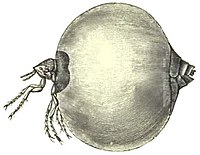
Photo from wikipedia
The speciation and morphological changes of α-U3O8 following aging under diel cycling temperature and relative humidity (RH) have been examined. This work advances the knowledge of U-oxide hydration as a… Click to show full abstract
The speciation and morphological changes of α-U3O8 following aging under diel cycling temperature and relative humidity (RH) have been examined. This work advances the knowledge of U-oxide hydration as a result of synthetic route and environmental conditions, ultimately giving novel insight into nuclear material provenance. α-U3O8 was synthesized via the washed uranyl peroxide (UO4) and ammonium uranyl carbonate (AUC) synthetic routes to produce unaged starting materials with different morphologies. α-U3O8 from UO4 is comprised of subrounded particles, while α-U3O8 from AUC contains blocky, porous particles approximately an order of magnitude larger than particles from UO4. For aging, a humidity chamber was programmed for continuous daily cycles of 12 “high” hours of 45 °C and 90% RH, and 12 “low” hours of 25 °C and 20% RH. Samples were analyzed at varying intervals of 14, 24, 36, 43, and 54 days. At each aging interval, crystallographic changes were measured via powder X-ray diffraction coupled with whole pattern fitting for quantitative analysis. Morphologic effects were studied via scanning electron microscopy and 12-way classification via machine learning. While all samples were found to have distinguishing morphologic characteristics (93.2% classification accuracy), α-U3O8 from UO4 had more apparent change with increasing aging time. Nonetheless, α-U3O8 from AUC was found to hydrate more quickly than α-U3O8 from UO4, which can likely be attributed to its larger surface area and porous starting material morphology.
Journal Title: ACS Omega
Year Published: 2021
Link to full text (if available)
Share on Social Media: Sign Up to like & get
recommendations!